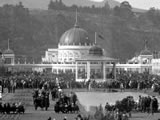What happened that day?
See historic events for any day of the year by entering the date below. Why not try your birthday?
Kiwi of the Week
Today in History

1925 NZ and South Seas International Exhibition opens
On a fine November day the Governor-General, Sir Charles Fergusson, opened the New Zealand and South Seas International Exhibition in Dunedin. An increase in visitors in the weeks that followed saw the 1926 census incorrectly report a growth in the city's population. By the time the exhibition closed in May 1926 it had attracted over 3.2 million visitors, more than double New Zealand's total population at the time.
Dunedin already had a proud history of mounting international exhibitions. In 1865, prospering from the gold rushes of the early 1860s, it became the first New Zealand centre to host such an exhibition. It mounted another in 1889. Christchurch also hosted international exhibitions, in 1882 and 1906. The latter exhibition, sited in Hagley Park, was the largest held in New Zealand at that time. Architect Edmund Anscombe, who was credited with instigating Dunedin's 1925 international exhibition, hoped to eclipse them all.
But while Christchurch had a ready site in the form of Hagley Park, the same could not be said for Dunedin. Lake Logan, the site eventually accepted by the exhibition's directors, ‘was spacious, convenient in situation and picturesque in its setting'. It was also a lake. Only one eighth of it had been reclaimed, and more than mere reclamation was required to transform the site. In all, 25,000 loads of clay and 3000 loads of soil were deposited for the lawns and gardens; 2500 trees and shrubs and 12,000 herbaceous and bedding plants were planted, and 600 packets of seeds were sown.
If the creation of Logan Park was spectacular, the exhibition buildings were no less impressive. Anscombe designed ‘a series of seven pavilions grouped on two sides by a Grand Court and converging by colonnaded passages towards a Festival Hall surmounted by a magnificent dome'. The buildings occupied approximately 64,750 sq m (16 acres). Visitors were able to tour almost the entire exhibition under cover. So exhaustive were the possibilities that many residents probably took up the option of a weekly or seasonal pass.
Among the wealth of entertainment options on offer was the Second Battalion of the 93rd Argyll and Sutherland Highlanders, and the immense exhibition choir. For light relief there was the amusement park, complete with a 430 m (1400 feet) long scenic railway. The restaurant, tea rooms and rest rooms provided visitors a welcome retreat from the festivities.
For the countries and provinces exhibiting, it was an opportunity to provide information on their key industries and to sell themselves as a tourist destination. The international side was dominated by Britain and her colonies, with elaborate ‘courts' provided by Australia, Canada and Fiji. Interestingly, Australia's modest display on wines was outshone by one on canned fruits, said to be ‘one of the finest ... displays ever made at any exhibition'. Fruit also featured in the provincial courts, with Otago taking the opportunity to provide samples of Central Otago fruit.
Exhibits mounted by the British and New Zealand governments were just as elaborate. Visitors to the British government pavilion were educated on the growth and means of defending the British Empire. The New Zealand government provided visitors with an insight into every aspect of government service. Exhibits ranged from the Department of Agriculture's demonstration plots to the Prisons Department's display of the ‘well balanced round of work, education and recreation' available to prisoners.
It appears people never tired of the exhibition in the 24 weeks it was running – the closing Saturday had a record attendance of 83,935. It would be a long wait for the next exhibition on a similar scale: the Centennial Exhibition at Rongotai, Wellington, which ran from 8 November 1939 to 4 May 1940.
Image: scene from the Exhibition (Timeframes)














